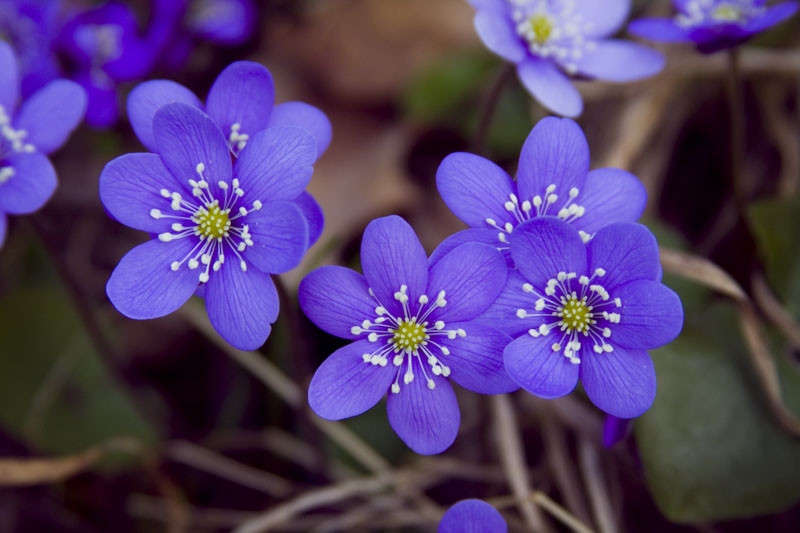jacksondwj.com – Roundleaf Liverleaf (Hepatica nobilis), also known simply as Hepatica, is a charming woodland wildflower admired for its delicate, early-spring blooms and distinctive round, lobed leaves. Native to Europe, Asia, and North America, this perennial plant is one of the first to flower in the spring, often blooming before trees fully leaf out. Its soft, pastel-colored flowers bring a much-welcomed splash of color to forest floors and shaded gardens.
Appearance and Growth
Roundleaf Liverleaf is a low-growing plant, typically reaching a height of 4 to 6 inches. The plant forms a rosette of evergreen, leathery, rounded leaves that are divided into three lobes. The leaves often take on a reddish or purplish hue in the colder months and are one of the plant’s identifying features. In early spring, delicate flowers bloom on short, hairy stems that rise above the foliage. The flowers can be white, pink, lavender, or blue, with six to nine petals surrounding a cluster of yellow stamens. The blooms are small but striking, measuring about 1 inch in diameter.
Flowering and Pollination
Roundleaf Liverleaf is one of the earliest flowering plants in the spring, often blooming as soon as the snow melts. Its flowers appear in March or April, adding a burst of color to woodland areas. The plant’s early bloom time provides an important source of nectar and pollen for pollinators like bees and early-emerging insects. Although the flowers are not strongly fragrant, they are highly attractive to these early pollinators, ensuring that the plant’s flowers are pollinated and seeds are produced.
Care and Cultivation
Roundleaf Liverleaf thrives in shaded or partially shaded areas, making it ideal for woodland gardens, shaded borders, or under trees. It prefers moist, well-drained soil that is rich in organic matter, similar to the leaf litter found in its natural woodland habitats. While it is tolerant of dry conditions once established, Hepatica benefits from occasional watering during prolonged dry spells, particularly in the summer.
This plant is relatively low-maintenance, requiring little care once established. It is also resistant to most pests and diseases, making it an excellent choice for gardeners looking for a resilient, early-blooming flower. Hepatica slowly spreads over time, forming clumps that can be divided every few years to create new plants or to manage its size.
Uses in Landscaping
Roundleaf Liverleaf is an excellent choice for naturalizing in shaded or woodland gardens, where its delicate flowers and attractive foliage can brighten up the forest floor. Its compact size makes it well-suited for the front of borders, rock gardens, or along shaded pathways. The plant works beautifully when combined with other early-blooming perennials such as trilliums, bloodroot, and spring ephemerals, creating a lush, layered look in woodland settings.
Due to its evergreen leaves, Roundleaf Liverleaf provides year-round interest, even after the flowers have faded. In autumn and winter, the reddish-purple foliage adds a touch of color to otherwise dormant garden beds, making it a valuable plant for creating year-round texture and beauty.
Historical and Medicinal Uses
The name “Liverleaf” comes from the plant’s rounded, lobed leaves, which were thought to resemble the shape of a liver. Historically, the plant was used in herbal medicine under the Doctrine of Signatures, a belief that plants resembling certain body parts could be used to treat ailments of that part. As a result, Hepatica was once used to treat liver and digestive issues. While its medicinal uses are no longer common, Roundleaf Liverleaf remains an important plant in traditional herbalism for its historical significance.
Ecological Importance
In its natural habitat, Roundleaf Liverleaf plays an essential role in supporting early-season pollinators. By blooming early in the spring, the plant provides a critical food source for bees and other insects emerging from winter dormancy. Its slow spread also helps stabilize soil in woodland environments, contributing to the overall health of the forest ecosystem.
Conclusion
The Roundleaf Liverleaf is a delicate and early-blooming wildflower that brings a touch of grace to woodland gardens and naturalized landscapes. Its soft, pastel-colored flowers, evergreen foliage, and historical significance make it a beloved plant for gardeners and nature enthusiasts alike. Whether planted in shaded borders, rock gardens, or woodland settings, Hepatica adds timeless beauty and ecological value to any garden, heralding the arrival of spring with its lovely, understated blooms.
